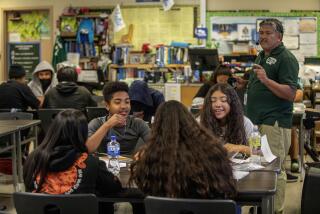The Solution Nobody Likes
- Share via
A proposal to add six weeks of classes to California middle schools appears to be meeting with little favor on Orange County campuses, with students moaning at the thought of losing precious summer days and educators saying it would disrupt families.
“I agree that we need to do something with the middle schools,” said Adele Heuer, principal of Pioneer Middle School in Tustin. “We either need more time or a lower class size. But my preference would be to see smaller classes. I think it would be far more effective than the 30-day extension.”
Heuer also worries that talented teachers would desert middle schools for shorter school years elsewhere--especially if they have school-age children who aren’t in middle school.
“I have many teachers who have children, and they would have issues of their children being out while they would still be in school,” she said. “It’s a big issue.”
Gov. Gray Davis proposed in early January to spend $1.45 billion to add 30 instructional days to the calendar of sixth-, seventh- and eighth-graders because their test scores lag behind those of elementary and secondary schoolers.
Teachers said that besides the rest value of the break, summer is a time when they make extra money at other jobs, attend classes and spend time with family--including children who have a standard school year.
“It’s going to disrupt families, and for that reason alone I wouldn’t support it,” said Frank Werner, an honors world history teacher at Los Alisos Intermediate School in Mission Viejo. “If you’re going to increase the school year, then increase it across the board. But I think 30 days is a little excessive.”
*
The plan would take the school year from 180 days to 210 days, the longest in the country. In the proposal, Davis gives districts the option of the extra 30 days; those who institute it would get 17% more in state funds, most of it to pay the extra salary of the middle school teachers. At most schools, students and teachers would have almost five weeks of vacation, starting in late July or August.
While teachers and administrators agreed that middle school is a critical time for youngsters and said they would like to see students score higher on standardized tests, they also said the details of Davis’ proposed extension are unclear.
“There are so many unanswered questions,” said Jerry Ray, principal of Los Alisos. “Would it be helpful for kids to have more instruction? Of course. Do all kids need it? Probably not.”
*
William Manahan, acting superintendent of Saddleback Valley Unified School District, said his district’s middle school scores are high and expressed concern about the longer school year being applied everywhere.
“The state at times has created programs they feel are generically appropriate to everybody, and they may not be,” Manahan said. “If [Davis] wants to spend this kind of money on middle schools, then let us use that money at our discretion.”
Students were predictably unhappy.
“It’s not fair for kids with high grades to have to suffer when we could be relaxing in the summer,” said Michael Wolde-Yohannes, 12, of Mission Viejo. “Don’t they have enough of our time during the year without taking more of our summer too?”
He said the school should set a grade-point average bar and if students fall below that standard, they should attend for the extra six weeks. That would provide an incentive to work hard and attend classes, he suggested.
“Bad students would become good students if they’d try harder,” Michael said.
Students also said they would rather be in charge of their own summer vacation.
“If you only have four weeks, there’s not much time to spend with your friends,” said Chris Scott, 13, of Mission Viejo, who said his summers are a sacred time of lounging around--and no homework. “Summer goes by fast enough. It’s school that seems to go very slow.”
Thirteen-year-old Ricky Alejo of Mission Viejo summed up his fellow students’ perspective: “Some kids might get smarter, but it would make everyone involved more miserable.”










